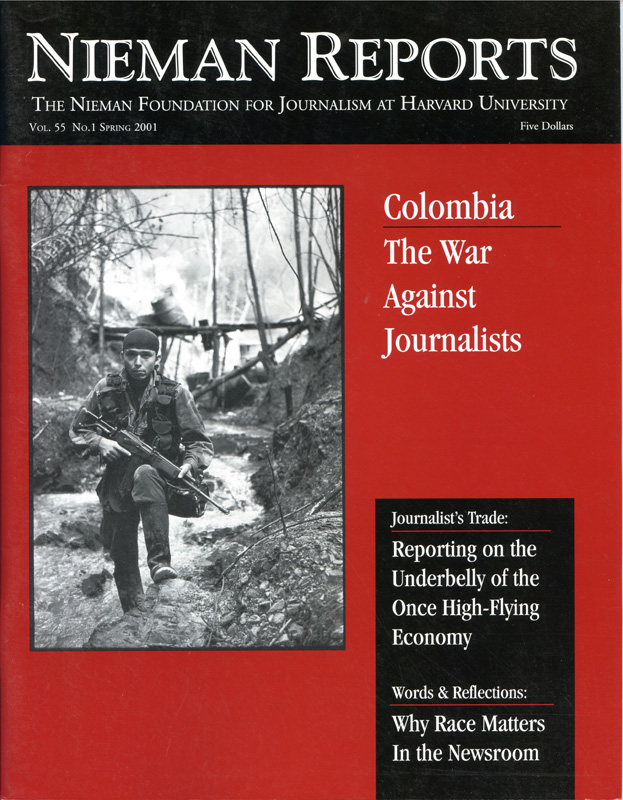Newspapers:
Newspaper of the Year—Newsday
For overall excellence in covering race and ethnicity and for developing a strategy to deal with the paper’s demographic challenge.
Gabriel Escobar, city editor, The Washington Post
For his stories on Latinos: “Dominicans in Black and White” and “The Other Pro Soccer.”
Angelo Henderson, reporter, The Wall Street Journal
For his Pulitzer Prize-winning stories on race: “Crime Scene” and “Color Code.”
Stephen Magagnini, reporter, The Sacramento Bee
For his series: “Getting Along,” and other stories on race and ethnicity.
Lonnae O’Neal Parker, reporter, The Washington Post
For her Style section story: “White Girl?”
The San Jose Mercury News
For special projects, “Majority of None” and “Diaspora,” and for the development of a race and demographics team.
Aaron McGruder, cartoonist
Creator of the multiracial comic strip “Boondocks,” distributed by Universal Press Syndicate.
Television:
Station of the Year—CBS News
For general excellence in coverage of race across a range of news programs. Alden Bourne, producer, “60 Minutes,”
CBS News
For “Vice Versa,” an unusual twist on affirmative action.
Paul Gallagher, producer, “60 Minutes,” CBS News
For “KIPP,” a report on education progress in minority neighborhoods in the Bronx and Houston.
Barbara Ciara, reporter-anchor, WVEC-TV, Norfolk, Virginia
For her report, “The N-Word.”
Emiko Omori, documentary filmmaker
For “Rabbit in the Moon,” a film about lingering tension over internment of Japanese Americans during World War II.
Lynn Redmond, producer, “ABC News 20/20”
For “Acting White,” an exploration of race and education.
WTVJ-TV, Miami, represented by Don Browne, president and general manager
For “Does Anyone Here Speak English?” and a portfolio of race and immigration stories.
Names and positions are given as they were in 2000 when selections were made.
Newspaper of the Year—Newsday
For overall excellence in covering race and ethnicity and for developing a strategy to deal with the paper’s demographic challenge.
Gabriel Escobar, city editor, The Washington Post
For his stories on Latinos: “Dominicans in Black and White” and “The Other Pro Soccer.”
Angelo Henderson, reporter, The Wall Street Journal
For his Pulitzer Prize-winning stories on race: “Crime Scene” and “Color Code.”
Stephen Magagnini, reporter, The Sacramento Bee
For his series: “Getting Along,” and other stories on race and ethnicity.
Lonnae O’Neal Parker, reporter, The Washington Post
For her Style section story: “White Girl?”
The San Jose Mercury News
For special projects, “Majority of None” and “Diaspora,” and for the development of a race and demographics team.
Aaron McGruder, cartoonist
Creator of the multiracial comic strip “Boondocks,” distributed by Universal Press Syndicate.
Television:
Station of the Year—CBS News
For general excellence in coverage of race across a range of news programs. Alden Bourne, producer, “60 Minutes,”
CBS News
For “Vice Versa,” an unusual twist on affirmative action.
Paul Gallagher, producer, “60 Minutes,” CBS News
For “KIPP,” a report on education progress in minority neighborhoods in the Bronx and Houston.
Barbara Ciara, reporter-anchor, WVEC-TV, Norfolk, Virginia
For her report, “The N-Word.”
Emiko Omori, documentary filmmaker
For “Rabbit in the Moon,” a film about lingering tension over internment of Japanese Americans during World War II.
Lynn Redmond, producer, “ABC News 20/20”
For “Acting White,” an exploration of race and education.
WTVJ-TV, Miami, represented by Don Browne, president and general manager
For “Does Anyone Here Speak English?” and a portfolio of race and immigration stories.
Names and positions are given as they were in 2000 when selections were made.



